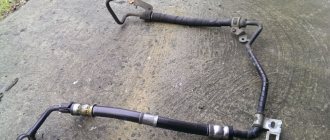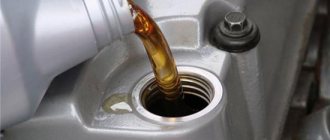02/26/2022 5,931 Lubrication system
Author: Victor
The hydraulic booster is the main component in the steering system of Ford vehicles. Thanks to the amplifier, simplified steering wheel control is provided. This system requires periodic diagnostics and maintenance, including oil changes. Find out from this material about Ford Focus 2 power steering fluid, which you can replace on your own.
[Hide]
When is an oil change required?
First, let's look at when it is necessary to change the power steering fluid and what is the frequency of replacement. According to technical regulations, the manufacturer fills this consumable into the system for the entire service life of the vehicle. But as a result of prolonged operation of the hydraulic system of a Ford Focus restyling, pre-restyling 2008, 2013 (or other year of manufacture), the quality of the lubricant may deteriorate during the active operation stage.
It is necessary to periodically check the condition of the oil, as well as its volume in the expansion tank. It is located in the engine compartment, on the right, near the engine mount.
Expansion tank for amplifier fluid
To effectively determine the quality of a consumable, you will need a syringe, with which you take a little oil from the tank and then drop it on a piece of paper or a napkin. The hydraulic booster system can use two types of oil - red and green. If you drop grease onto the paper and see that the color has not changed, then the consumable does not need to be changed. If the liquid has turned brown or black, and a burning smell is coming from the reservoir, then the substance must be changed. The need for replacement is indicated by deterioration in the quality of vehicle control and the appearance of extraneous sounds when turning the steering wheel.
Let’s summarize the “symptoms”, the presence of which indicates the need to change the fluid:
- The appearance of extraneous sounds, creaking when turning the steering wheel. This can happen on both a cold and warm engine.
- Difficulty turning the steering wheel. The driver needs to put in more effort to turn.
- Deterioration in the quality of consumables. Changing the original color of the liquid.
- Presence of a burning smell in the expansion tank.
Experienced car enthusiasts recommend changing the oil every 2-3 years, or at least every 100 thousand kilometers.
What's suitable?
What to fill? This question interests every motorist whose car is equipped with a hydraulic booster. Speaking specifically about the second generation Focus, you can buy WSA/M2C195/A. It is worth paying attention to Ravenol-PSF. If it is not possible to purchase one of the proposed options, then when choosing an oil, look at the existing composition. It is important that the parameters exactly meet all factory requirements class=”aligncenter” width=”640″ height=”480″[/img]
You definitely need to figure out how much liquid to add. For Focus 2 you will need about two liters, and therefore there is no point in buying more.
Which oil is better to choose?
Original product for Focus power steering
Before changing the lubricant in the hydraulic booster, you need to determine what brand of fluid should be filled. The original power steering oil belongs to the category of synthetic lubricants. The manufacturer recommends casting original products, since they make it possible to ensure reliable and stable operation of the system. This product performs its functions at air and motor temperatures from -40 to +120 degrees.
Options for filling into Ford power steering:
- Ford WSA/M2C938/A. The product is red, its article number is 1776431. The cost of one liter of lubricant is on average 1,400 rubles.
- Liquid for Ford M2C204/A2 USA. This is a green original liquid with article number 1781003, which is a cheaper option, its cost is approximately 600 rubles per liter of lubricant.
As analogues, the use of red Motorcraft Merkom LV oil is allowed. Another inexpensive option is SWAG Febi (up to 600 rubles per liter).
The ABC Ford channel has provided a video that will allow you to choose a power steering fluid.
DIY partial replacement
A simplified replacement option is allowed only if the car owner knows exactly what type of composition is currently poured into the power steering reservoir and has the opportunity to use the appropriate composition. The reason for a partial replacement is contamination of the tank, stains or suspension on the surface of the fluid after a long period of non-use of the car.
- Unscrew the cap of the power steering reservoir, and using a 20-cc syringe + elastic tube, pump out the contaminated oil.
- Fill in new fluid, focusing on the upper mark, and put the plug in place.
Checking the level and topping up
Learn more about how to check the amount of lubricant in the power steering system. Diagnostics of the consumable level is carried out on a flat surface. The oil reservoir has two marks: MIN and MAX. If the power unit of the machine is turned off, then the volume of working fluid will most likely be maximum. If the lubricant level is closer to the minimum, then lubricant must be added to the system. How much to pour depends on the volume that is missing.
How to detect a leak?
To independently identify the location of the leak, do the following:
- Stop the engine and wait until it cools down.
- Wipe all components of the steering system with a rag, especially the pipes and connections.
- Check the amount of lubricant in the expansion tank. If necessary, add liquid.
- Start the power unit and turn the steering wheel left and right as far as possible. As a result of rotation, the lubricant will begin to actively circulate throughout the system. If there is damage, you will be able to see the leak. Depending on the problem, decisions are made to eliminate it.
Causes of leakage and their elimination
Most often, the steering rack leaks in Focus cars. If there is a malfunction in the operation of this unit, this leads to leakage of consumables.
Signs of a problem:
- While driving, a knocking sound appears in the area of the rack, which can be clearly heard through the steering wheel.
- There was a gap when turning the steering wheel.
- Extraneous sounds have appeared in the operation of the hydraulic booster pumping device.
- The driver has to exert more effort to rotate the steering wheel.
One of these “symptoms” indicates a lack of fluid and the need to diagnose the system for leaks. Malfunctions associated with the operation of the rack can be eliminated with your own hands. To do this, the rack must be removed from the car and disassembled. All worn components found during diagnostics must be replaced. Then the rack is assembled and then installed in the car.
The reason may be that the power steering pump is not working. The pumping device operates under conditions of high loads, so over time, malfunctions appear in the operation of the unit. Also, the reason may lie in a violation of the tightness of the device or damage to the pipes and lines through which the lubricant circulates. To solve the problem, you need to visually diagnose the hoses and replace them. If there are cracks or other defects, the lines must be replaced. It is advisable to overhaul the pumping device and install new seals in it.
Sometimes it happens that the steering wheel turns freely, but as the engine warms up, you have to put more effort into turning it. This indicates a malfunction of the pumping device and leakage of consumables. The unit must be dismantled and disassembled. The device is visually inspected for damage. All failed parts are replaced with new ones, and before assembly, all elements are wiped with alcohol or solvent. If the seals of the lines are broken, all pipes of the system must be carefully inspected for reliability and strength. If you doubt the quality of the tightness of the connecting components, they must be updated and securely fixed.
Main functions and characteristics of power steering oils
Power steering fluid performs the following functions:
- pressure transmission between the pump and actuator units;
- lubrication and cooling of amplifier structural elements;
- removal of wear products;
- reduction of friction between elements.
The working fluid in power steering is a liquid, divided into two categories:
- Mineral based, which is not aggressive to rubber O-rings. The oil additionally protects the material, preventing it from cracking due to temperature changes. The disadvantage is increased viscosity (especially in cold weather), short service life and a tendency to intensive foam formation.
- Synthetic liquids that destroy rubber parts (except for products made from special materials). The oil has an increased cost, which is compensated by an increased resource, as well as a uniform viscosity that is little dependent on temperature.
Preparing for replacement
To complete the changing procedure, you will need the oil itself, green or red. Any lubricant is not suitable, buy either the original or a high-quality analogue, which we wrote about above. A complete replacement will require at least two liters of consumables. In general, the process of changing in Ford Focus cars does not cause any particular difficulties, but with an assistant it will be easier to complete this task.
You will need a pipe equipped with a special fitting at the end. The length of the hose will be at least one meter, and its diameter should be the same as the return line. To determine the return diameter, look at the fluid reservoir under the hood. There are two pipes suitable for the tank: one connects to the pump, the other goes directly to the tank. You will need another pipe, but its length will be shorter, and there will be a plug at the end. Also prepare a container in which you will collect the used oil.
User Alex M published a video showing the process of replacing fluid in the Focus power steering.
Power steering - what is it and what is it for?
The hydraulic booster is one of the components of the steering mechanism. Its main task is to provide so-called feedback between the driver and the car while driving the latter. In addition, power steering improves vehicle stability while driving. This element allows you to increase the comfort of the car.
Changing the power steering oil is a mandatory process that ensures the functionality of the device. The Ford automaker says that replacing the power steering fluid on the second Focus may not be necessary for the entire service life of the car, but this happens extremely rarely. Experienced Ford owners change the fluid at least once a year (40-50 thousand km), because... it loses its properties, does not hold pressure, and absorbs moisture.
Stages of work
To replace the power steering lubricant, do the following:
- Drain the used liquid. Stop the engine and open the fluid expansion tank. Unscrew the bolts that secure it and disconnect the pipes connected to it. This will lead to consumables leaking out, so place a container in advance (maybe a cut-off bottle) with a volume of at least two liters.
- We connect the clamp. Using long-end pliers, hook the clamp from the return line and move it to the side. The clamp is connected to the expansion tank with consumables.
- We provide access. Disconnect the return line pipe, and then install the fitting from a previously prepared hose. Instead of a pipe, a tube with a plug is used.
- We fill in new material. Open the reservoir cap and fill it with new lubricant. Consider some points here. While you are adding lubricant, your assistant should start the power unit. When filling, monitor the color of the consumable material, which is pumped out of the reservoir under the influence of pressure in the pump. When fresh lubricant comes out of the tank, differing from the used one in color and smell, the engine must be stopped. When filling, do not allow air to enter the system, this will lead to the formation of plugs that will subsequently have to be removed.
- The final stage. Top up to the maximum level, then start the engine and let it run. Make a test drive and check the lubricant level again. Add fluid to the system if necessary. All components are assembled in reverse order.
Photos of replacing consumables are shown below.
1. Drain the lubricant from the reservoir and plug the return line
2. Fill the hydraulic steering system with new oil.
When replacing lubricant, do not allow it to come into contact with the timing belt, otherwise it will cause rapid wear.
What tools will you need?
You can change the oil in the unit yourself, saving on service station fees. The process does not require complex equipment, special knowledge or unusual skills. Before you begin the replacement, you should make sure that all the tools necessary for a successful procedure are available and at hand.
To change the oil in the power steering Ford Focus2 you will need:
- hose 1-1.5 meters long with a fitting;
- jack;
- waste oil container;
- cloth gloves;
- rags;
- new oil.
Consequences of untimely replacement
If the fluid is replaced at the wrong time, this usually causes accelerated wear of the components of the hydraulic booster system. Because of this, power steering parts will begin to wear out faster and fail. First of all, oil seals and gaskets are subject to wear, the appearance of defects on which leads to lubricant leakage.
What can happen as a result of untimely replacement:
- failure of the steering rack;
- lubricant leakage from the system;
- the appearance of creaking and other noises when turning the steering wheel;
- failure of the steering gear;
- the appearance of difficulties when turning the steering wheel.
What mistakes should you avoid when operating power steering?
To avoid problems in the operation of the hydraulic booster, you must follow certain rules for using the system:
- Correct steering wheel position. The steering wheel should not be held in the extreme left or right position for a long time, but turn off the power unit by turning the wheels. This negatively affects the operation of the pumping device, since the load on it increases. To reduce the load level, the steering wheel must be moved a few centimeters from its extreme position.
- Precautionary measures. Limit vehicle operation if the hydraulic booster does not work.
- Oil level control. Always check the lubricant level in the expansion tank. If the lubricant volume is too low, the cause must be determined and eliminated, and before that, do not use the machine.
- Be careful when parking. Do not overload the hydraulic booster when parking the vehicle. If you feel that the side surfaces of the wheels are resting against the curb, do not continue to turn the steering wheel.
- Rules for winter. Before starting a trip in winter, you need to warm up the hydraulic booster by smoothly turning the steering wheel in different directions. The amplitude of rotation should not be large.
Power steering fluids
Power steering oil serves as the link between the piston and the hydraulic pump. It lubricates device parts, reduces friction, prevents overheating, corrosion and oxidation.
Power steering fluids differ in oil composition, level of density and viscosity, and mechanical properties.
There are fundamental differences between synthetic and mineral liquids. The former are recommended to be used with permission from the vehicle's operating instructions, since some components of synthetic oils can adversely affect rubber parts.
Mineral fluids are much cheaper and more versatile; they do not cause any harm to rubber and polymers, which is why they are very popular among car owners.
Oils also differ in color - red, yellow and green liquids have specific properties, composition and areas of application. The choice of oil color for power steering depends not on the desire of the driver, but on the recommendations of the car manufacturer.
Video “How to pump the power steering yourself?”
If after replacing the fluid the hydraulic booster does not work, check out the video made by user Sasha Petrov, which will help you figure out how to bleed the system.
Do you have any questions? Specialists and readers of the AUTODVIG website will help you ask a question
Was this article helpful?
Thank you for your opinion!
The article was useful. Please share the information with your friends.
Yes (100.00%)
No
X
Please write what is wrong and leave recommendations on the article
Cancel reply
Rate this article: ( 7 votes, average: 5.00 out of 5)
Discuss the article:
Why is low-quality oil dangerous?
Purchasing counterfeit products can harm human health and damage vehicle components. When choosing power steering fluid, you must follow the same rules as when buying motor oil. The lubricant must be produced by a reputable manufacturer and purchased from an official representative. This will minimize the risk of purchasing low-quality oil and the consequences of its use.
Loss of properties at elevated temperatures
Low-quality oil begins to break down at elevated temperatures, clots form in it, which clog the pump and lines. The minimum problem in this case will be an increase in the force on the steering wheel, but the possibility of component failure cannot be ruled out.
During operation, the liquid reaches temperatures up to +85 ºС (cases of stronger heating have been noted). The radiator in the system reduces the temperature, but in hot weather or when driving intensively, heating is inevitable.
Release of hazardous vapors
The additive complex begins to boil away at elevated temperatures. This is especially true for cheap components that are not suitable for such operating conditions. The formed vapors enter from the engine compartment into the air supply channels for the vehicle interior. Theoretically, they can have a negative impact on the driver and passengers.
How to change power steering oil
There are two repair methods:
- with a complete oil change;
- with partial drainage of liquid.
To carry out independent replacement, you will need materials and equipment:
- new clean oil in the quantity specified in the technical documentation;
- a medical syringe with a volume of 40-50 ml, necessary for pumping out liquid from the tank;
- extension tube that fits onto the syringe nozzle;
- a container for collecting used oil (usually an old canister or a 1.5-2.0 liter plastic bottle is used);
- rags;
- gasoline or carburetor cleaner (for washing parts);
- funnel;
- a screwdriver or special pliers for removing clamps;
- set of heads (depending on the design of the car).
Oil drained from the power steering must be disposed of; pouring it onto the ground or into a sewer is prohibited.
Installing the car on a lift
When changing the oil completely, it is necessary to hang the front wheels of the car, which will allow you to rotate the steering wheel with the engine off. The car is installed on a lift according to the standard procedure. In the absence of equipment, it is possible to use the installation of stands under the thresholds. If a partial fluid change is being carried out, a lift is not required.











